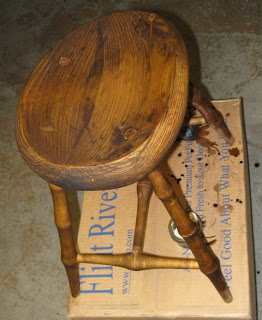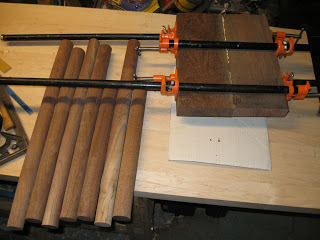When this first stool is finished, I expect it will look basically fine, and will not betray the troubles which presented themselves during the construction process. Mistakes are easier to hide under a painted surface. Some mistakes required me to build new parts, so you’d have to look in my scrap bin for the evidence. Nonetheless, I’d rather not repeat these errors.
I’m going to write a list of all of the problems I would have rather avoided. I’m also going to try to describe why they happened, and find ways to avoid repeating them. I don’t necessarily think the results of this exercise will be useful to anyone but me, but maybe the example of the process I used will be. I intend to update this list as I go along until the stool is finished.
In both chair classes I took, I made relatively few mistakes. In retrospect, although I avoided mistakes at the time, I’m not sure I remember how I avoided them; and because I avoided mistakes, I didn’t learn how to fix them. As I expected, I wouldn’t really know how to make a chair (or even a stool, the easy half of a chair) until I did it by myself.
I’m sure this will bore you, unless you want to make fun of me. But I’ll probably refer to it again in the future, and “future me” is as much of a part of my target audience as you are.
Problem: Seat holes were drilled at the wrong angle. This required major adjustment during reaming, and left gaps around the legs in the seat top (which were luckily filled when I wedged them).
Cause: Although I used a bevel gauge to site the leg angle, I didn’t also use a square to make sure I was square to the sight line.
Solution: Use a square.
Problem: 2 side stretchers were cut too short and I needed to turn replacements.
Cause: I didn’t know how long my folding rule segment was.
Solution: Remember the rule is 7″ long.
Problem: While drilling a leg hole, the leg rotated in the V-blocks, ruining the hole and requiring a new leg.
Cause: Insufficient clamping strenth.
Solution: Use better clamps.
Problem: All 5/8″ holes took too long to drill and/or were burnished; bit required constant sharpening.
Cause: Dull drill bit. It seems to really suck.
Solution: Get a new bit, or try a new grind on the old bit.
Problem: A leg split during stretcher assembly, requiring building a new leg. Two side stretchers had minor cracks during stretcher assembly.
Cause: Tenons were cut too large, or with a taper; inappropriate wood used to turn the leg.
Solution: Learn the proper size to cut the tenons, and how to achieve consistent results. Don’t use open-grained wood for legs, it splits too easily.
Problem: A stretcher tenon was too small. I fixed it by gluing cloth around it to increase the diameter where it was inserted into the leg.
Cause: Tenon cut too small.
Solution: Learn the proper size to cut the tenons, and how to achieve consistent results.
Problem: Tapered leg tenons have a shoulder where the depth reference mark is, making it hard to seat them properly.
Cause: The tapered tenon cutter’s major diameter is smaller than the depth reference diameter on the stool’s plan.
Solution: Use a smaller depth reference diameter, or stop using the taper cutter (use the lathe instead).
Problem: Leg wedges didn’t drive very far into the seat.
Cause: Wedge angle too great.
Solution: Cut thinner wedges at a lower angle.
Problem: Leg wedges were hard to start in the tops of the legs.
Cause: Leg slot was squeezed shut by the seat.
Solution: File a v-notch in the wedge slot before inserting legs into the seat.
Problem: When wedging the legs, the cookies leftover from turning the legs broke off the bottom, and chipped the bottom of the legs.
Cause: I didn’t trim the cookies off after turning the legs.
Solution: Trim the cookies.
Problem: Stool wasn’t levelled properly: it rocks slightly on some surfaces.
Cause: My bench isn’t perfectly flat.
Solution: Move my bench around on the floor until it’s flat, or wedge one of the legs.
Things which were harder than they should have been, or took longer than they should have, even if they weren’t necessarily mistkaes :
- Cutting wedges for the legs
- Drilling 5/8″ holes
- Trying to trim oversized stretcher tenons to the perfect size, off the lathe
Creative solutions to problems I’d prefer to avoid (Yes, I know you likely have no clue what I’m talking about, but I have to take notes somewhere and it might as well be here):
- Glue one or more layers of cloth to a round tenon to increase the size of tenons if you trim the tenons too small or ream the leg holes too large. I learned this in Brian Cunfer’s class.
- When I split a leg, but already had the undercarriage partially assembled, it was impossible to insert the leg in the undercarriage enough to measure a drilling angle for it. Instead, I mounted my broken leg in the v-blocks to set its reference line parallel to the table, and then replaced it with the good leg before drilling using my reference angle. Since the legs are both straight, and differing leg diameters only move it horizontally, the angle came out correct.
There’s certainly no danger of perfection in my craft. But my willingness to screw up, and to say “good enough” when it’s good enough helps me get something done, and allows me to enjoy myself overall, even if the process isn’t going as perfectly as I might prefer. I can’t get better without doing it, but in order to do it at all I need to make some mistakes.
 Last week, we had a wind storm with wind bursts up to 90mph. Since then, I’ve been looking for downed trees that people have thoughtfully cut up into portable pieces. Yesterday, we found some logs.
Last week, we had a wind storm with wind bursts up to 90mph. Since then, I’ve been looking for downed trees that people have thoughtfully cut up into portable pieces. Yesterday, we found some logs.








